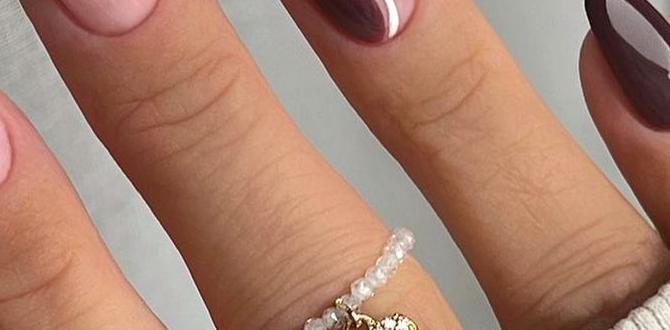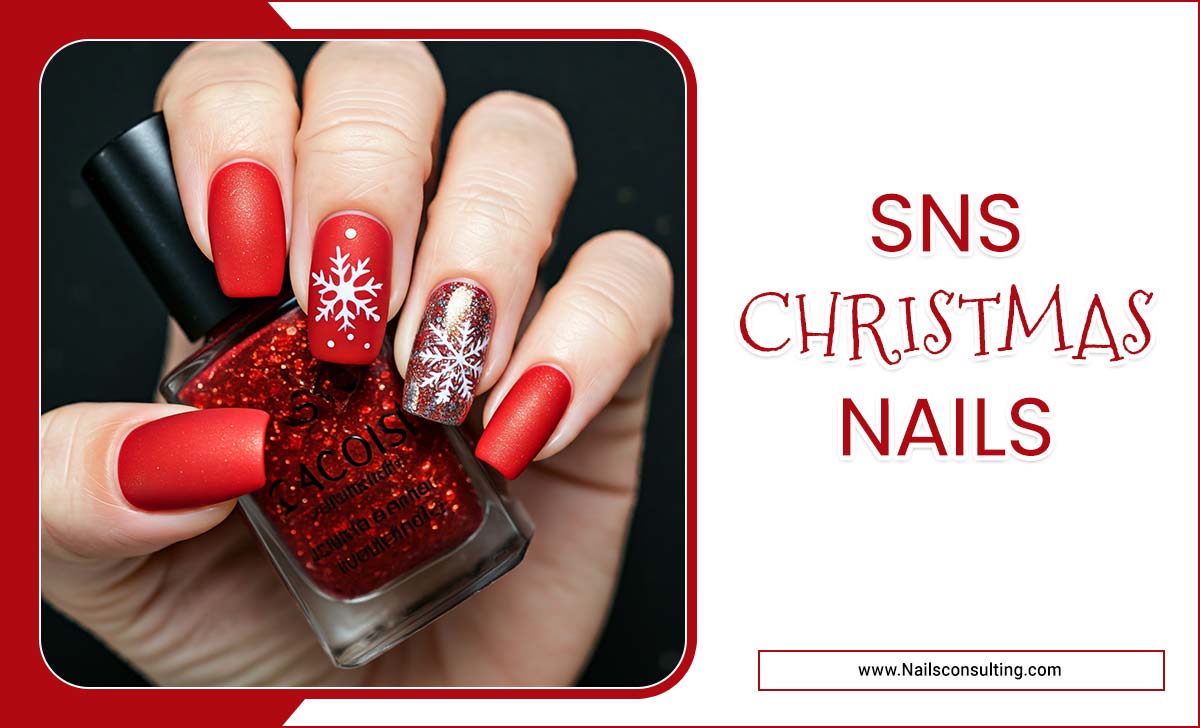Learn to create stunning floral nail designs with hand-painted roses effortlessly! This beginner-friendly guide breaks down the popular trend into simple steps, perfect for achieving salon-quality results at home. Elevate your manicure with timeless, elegant rose nail art.
Welcome to Nailerguy! Are you captivated by the dreamy charm of floral nail designs featuring hand-painted roses but feel intimidated by traditional art requiring a super steady hand? You’re not alone! Many of us admire intricate nail art, wishing we could replicate that delicate beauty without years of practice. The good news is, achieving elegant rose nail art at home is easier than you think! Forget complicated techniques; we’re diving into a simple, approachable method that will make your nails bloom. Get ready to transform your fingertips into tiny canvases of art.
Let’s explore how to bring this classic floral beauty to your nails!
Why Hand-Painted Roses Are Timeless
Hand-painted roses on nails aren’t just a trend; they’re a classic statement of elegance and femininity. Their enduring appeal lies in their versatility and the personal touch they bring to any manicure. Whether you opt for a single, delicate rose or a scattering of blooms across your nails, this floral nail design offers a sophisticated yet approachable way to express your personal style. They can be adapted to any color palette, from soft pastels to bold jewel tones, making them suitable for any occasion, season, or personal preference.
The Allure of Floral Nail Designs
Floral nail designs have always been a favorite in the beauty world. They bring a touch of nature’s beauty right to your fingertips, offering a refreshing and vibrant aesthetic. Among all floral patterns, the rose holds a special place. It symbolizes love, beauty, and passion, making it a powerful motif for self-expression. A hand-painted rose adds an artistic and personal touch that machine-made decals often lack. It’s this blend of classic symbolism and bespoke artistry that makes floral nail designs with hand-painted roses so captivating.
Getting Started: Essential Tools for Your Rose Nail Art
Before we dip our brushes, let’s gather your artistic arsenal. You don’t need a professional studio – just a few key items will set you up for success. Having the right tools makes all the difference, turning what might seem daunting into a fun, creative process.
Here’s what you’ll want to have on hand:
- Base Coat: This protects your natural nails and helps your polish adhere better. Look for a good quality base coat, preferably one with strengthening properties if your nails are prone to breaking.
- Top Coat: Essential for sealing your design, adding shine, and ensuring your masterpiece lasts. A quick-dry top coat is a lifesaver for busy bees!
- Nail Polish Colors:
- Base Color: This is the main shade for your nails (e.g., nude, white, pastel pink, or a deep shade).
- Rose Petal Colors: Typically shades of red, pink, or even white for delicate roses. You might also want a lighter shade for highlights.
- Leaf/Stem Color: A good quality green in a shade you love.
- Detail Brushes: This is where the “hand-painted” magic happens!
- Fine-liner Brush: For drawing thin lines, stems, and outline details. A brush with a tip of about 7-10mm is ideal.
- Small Round Brush (Size 0 or 1): Perfect for creating the petal shapes of the rose.
- Dotting Tool: While not strictly for painting roses, it’s great for adding small accent dots or creating the center of your rose if you prefer.
You can find these specialized nail art brushes online or at beauty supply stores. For beginners, starting with a kit that includes a few essential brush shapes is a great investment.
- Nail Polish Remover & Cotton Swabs/Pads: For cleaning up any little mistakes. Cotton swabs are fantastic for precise cleanup around the cuticle and nail edges.
- Clean-up Brush (Optional but recommended): A small, flat brush (like a tiny concealer brush) dipped in nail polish remover can create super clean lines around your cuticles and sidewalls.
- Palette or Piece of Foil: To place small dots of polish you’ll use for painting.
Don’t worry if you don’t have every single brush size right away. Often, one or two detail brushes and practice are all you need to start creating beautiful roses. You can even experiment with the tip of a toothpick in a pinch for very basic designs, though a proper brush offers much more control.
Preparing Your Nails for Artistry
A flawless canvas is key to a flawless design. Taking a few moments to prep your nails ensures your polish adheres well, your design looks clean, and your manicure lasts longer. This step is often overlooked, but it’s crucial for achieving that professional finish.
Here’s how to get your nails ready:
- Cleanse: Start by removing any old nail polish. Use a good quality nail polish remover that isn’t too harsh on your nails.
- Shape: Gently file your nails into your desired shape. Whether you prefer square, round, or almond, ensure the edges are smooth. Filing in one direction prevents snagging and weakening the nail.
- Cuticle Care: Gently push back your cuticles with an orange wood stick or a cuticle pusher. If you have dry cuticles, you can apply a bit of cuticle oil and let it soak in before pushing them back. Avoid cutting your cuticles, as this can lead to infection and damage. For more on healthy cuticle care, check out this informative guide from the American Academy of Dermatology.
- Buff: Lightly buff the surface of your nails. This creates a smooth surface for the polish to adhere to and removes any natural oils that might prevent polish from sticking. Be gentle – you’re not trying to thin your nail, just create a slight, even texture.
- Wipe Down: Before applying any polish, wipe your nails with a lint-free cloth or a cotton pad soaked in rubbing alcohol or nail polish remover. This removes any dust from buffing and any remaining oils.
- Base Coat Application: Apply one thin, even coat of your base coat. Let it dry completely. This step is non-negotiable for nail health and polish longevity!
Proper nail prep is like the foundation of a beautiful house – it ensures everything built upon it stands strong and looks its best. Once your nails are prepped and your base coat is dry, you’re ready for the exciting part: painting!
Step-by-Step: Creating Hand-Painted Roses
Now for the fun part! We’ll break down creating hand-painted roses into simple, manageable steps. Remember, perfection isn’t the goal here; it’s about enjoying the creative process and expressing yourself. Even if your first few attempts aren’t magazine-cover ready, they’ll still be beautiful and uniquely yours.
Step 1: Apply Your Base Color
Paint your nails with your chosen base color. This could be a classic nude, a soft white, a gentle pastel, or even a sophisticated dark shade. Ensure you apply two thin, even coats for full opacity, allowing each coat to dry thoroughly before moving on. A well-applied base color makes your floral design pop!
Step 2: Prepare Your Palette
On your foil or palette, place a small dot of the color you want for your rose petals (e.g., red, pink). Next to it, if you want to add dimension, place an even smaller dot of a lighter shade of the same color for highlights, or a very small dot of white. Also, place a small dot of your green polish for the leaves.
Step 3: Painting the Rose Petals
This is where your detail brush comes into play.
- Dip your small round brush into your rose petal color. Don’t overload the brush; a little polish goes a long way.
- Start with the center: Create a small swirl or a “C” shape in the middle of your nail to represent the tightly coiled center of the rose.
- Add outer petals: Now, using slightly curved strokes, build outwards from the center. Imagine you’re drawing curved “U” shapes or crescent moons that subtly overlap and surround the initial swirl. Each stroke represents a petal unfurling. Don’t try to make perfect, identical petals. The variation is what makes it look hand-painted and natural.
- Add dimension (Optional): If you have a lighter shade or white, very lightly dip the tip of your brush into it and add a tiny highlight to the edge of a few petals. This adds depth and makes the rose look more realistic and vibrant.
Tip for Beginners: Start with simpler rose shapes. A basic swirl and a few “C” strokes can create a lovely rose effect. You can always add more detail as you become more comfortable.
Step 4: Adding Leaves and Stems
Once your rose is drying, it’s time for the greenery.
- Use your fine-liner brush or a small detail brush. Dip it into your green polish.
- Paint a thin stem extending from the base of your rose, or wherever you feel it looks best.
- Create leaves: For simple leaves, make two small, curved strokes starting from the stem and tapering to a point. Think of elongated “C” shapes mirrored on either side of the stem. You can also create small dots and connect them with a line to form a leaf shape.
Tip: Keep the lines delicate. Long, flowing stems and simple leaf shapes often look more elegant than thick, clunky ones.
Step 5: Adding Accents and Final Touches
Small Dots: Use your dotting tool or the tip of your fine-liner brush to add tiny dots around your rose or leaves, mimicking smaller buds or dew drops.
Outline (Optional): For a more graphic look, you can use your fine-liner brush with black or dark brown polish to very subtly outline some of your petals or leaves. This can add definition but isn’t necessary for a softer look.
Let it Dry: This is crucial! Ensure your entire design is completely dry before moving to the next step. This can take longer than you think, especially with multiple layers of polish. Patience here prevents smudging.
Step 6: The Seal of Approval – Top Coat
Once your design is bone dry, apply a generous, even coat of your top coat. Make sure to cap off the free edge of your nail by sweeping the brush along the tip. This helps prevent chipping and seals in your beautiful hand-painted roses. Let it dry completely.
You’ve done it! You’ve created a beautiful floral nail design with hand-painted roses. Admire your work – it’s a testament to your creativity and newfound nail art skills!
Variations to Explore with Your Floral Nail Design
Once you master the basic hand-painted rose, the possibilities for variation are endless! Don’t be afraid to experiment with colors, placement, and styles to make the design your own. Here are a few ideas to spark your creativity:
Color Play
Monochromatic Roses: Use different shades of the same color (e.g., light pink, medium pink, deep raspberry) to create depth and dimension in your roses.
Ombre Petals: Blend two or more colors within the same petal. You can do this by applying one color, then while it’s still wet, dabbing a second color on the tip and gently swirling them together with your brush.
Bold Backgrounds: Contrast your delicate roses with a dark, moody background color like navy, deep burgundy, or forest green for a dramatic effect.
Pastel Dreams: Opt for soft, muted tones for both the roses and the background for a dreamy, ethereal look.
Metallic Accents: Use metallic polishes for your base color or as highlights on the petals for a touch of glamour.
Placement and Style
Accent Nail: Focus your detailed rose design on just one or two accent nails, keeping the rest a solid complementary color.
Full Coverage: Scatter small roses and leaves across all nails for a lush, garden-inspired look.
Minimalist Roses: Paint just a single, small rose on the cuticle area or at the tip of the nail for a subtle, chic touch.
Rose Bouquets: Create a cluster of roses on one nail, perhaps with more intricate leaf work, for a focal point.
Reverse French Manicure: Paint the rose along the smile line of a reverse French manicure.
3D Effects (Advanced): For those feeling more adventurous, explore applying small 3D embellishments like tiny pearls or rhinestones strategically to mimic rose petals or dew drops after painting.
Adding Other Florals
Don’t limit yourself to just roses! Once comfortable, try incorporating other floral elements like:
Tiny buds: Use your dotting tool to create small dots that can be your rose buds.
Simple daisies or filler flowers: Add these with small white dots and a yellow center.
* Leaves and vines:** Extend the greenery with more complex vine patterns or different leaf shapes.
Mixing and matching these elements allows you to create truly unique floral nail designs that reflect your personal style and mood. The beauty of hand-painted art is its inherent individuality.
Pro Tips from Nailerguy for Flawless Roses
As your go-to nail enthusiast, I’ve picked up a few tricks along the way that can significantly elevate your hand-painted rose game. These tips focus on making the process smoother, the results cleaner, and your designs more stunning.
Here are some of my favorite professional tips for creating a gorgeous floral nail design with hand-painted roses:
-
Practice Makes Perfect (and Patience is Key!)
Don’t get discouraged if your first few attempts aren’t perfect. Start by practicing the strokes on a piece of paper or a practice nail tip. Get a feel for how the polish flows from your brush. The more you paint, the more natural it will become.
-
Control Your Polish Load
This is HUGE. Too much polish on your brush will lead to thick, blobby petals. Too little, and your lines will be wispy and broken. Aim for a smooth, controlled application. For roses, you want enough to create smooth curves, but not so much that it pools.
-
Thin Coats are Your Friend
This applies to base colors, rose petals, and leaves. Thin coats dry faster and provide a cleaner canvas for subsequent layers or detail work. They also prevent your design from looking bulky.
-
Use the Right Brush Shape for the Job
A fine-liner is for lines, a small round brush is for petals. Don’t try to force one brush to do everything. Understanding the purpose of each brush type will make your painting much more efficient and beautiful.
-
Clean Your Brushes (Properly!)
After each color or at the end of your session, gently clean your brushes with nail polish remover and then a little bit of soap and water. Gently pat them dry and store them flat or upright with the bristles pointing up to maintain their shape.
-
Don’t Be Afraid of Negative Space
Sometimes, less is more. If your rose feels a little overwhelming, add a few strategically placed leaves or dots, or even leave some space bare. Negative space can make your design feel airy and elegant.
-
Work in Good Lighting
This sounds obvious, but good, bright lighting makes a massive difference. It helps you see your strokes clearly, judge polish colors accurately, and avoid mistakes. A desk lamp or a well-lit vanity is ideal.
-
Seal Your Design with Confidence
A good top coat is your best friend. Don’t skimp on this step! A smooth, even top coat not only protects your art but also gives your nails a professional, high-gloss finish. Make sure it’s fully dry before anything comes into contact with your nails.
-
Consider Gel Polish for Longevity
If you want your hand-painted floral designs to last longer (weeks instead of days), consider using gel polish and a UV/LED lamp. The application process is similar for the painting part, but the results are incredibly durable. For more on gel nails, you can explore resources like this guide from the FDA on cosmetic product safety, which includes guidelines on UV lamps.
Remember, nail art is a journey. Embrace the process, enjoy the creativity, and celebrate the beautiful results you achieve. Your nails are a form of self-expression, so have fun with it!
Troubleshooting Common Nail Art Hiccups
Even with the best intentions, sometimes things don’t go exactly as planned. Don’t worry! Every nail artist, from beginner to pro, encounters little challenges. The key is knowing how to fix them.
Here’s a guide to troubleshooting common issues you might face with your floral nail design.
Problem: Smudged or Streaky Polish
Cause: Trying to paint too soon, overloading your brush, or applying polish too thickly.
Solution:
- Allow ample drying time between coats.
- Use thinner coats of polish.
- For detailed work, ensure your brush is cleaned of excess polish.
- If a smudge happens, gently use a clean brush dipped in nail polish remover to carefully lift the



